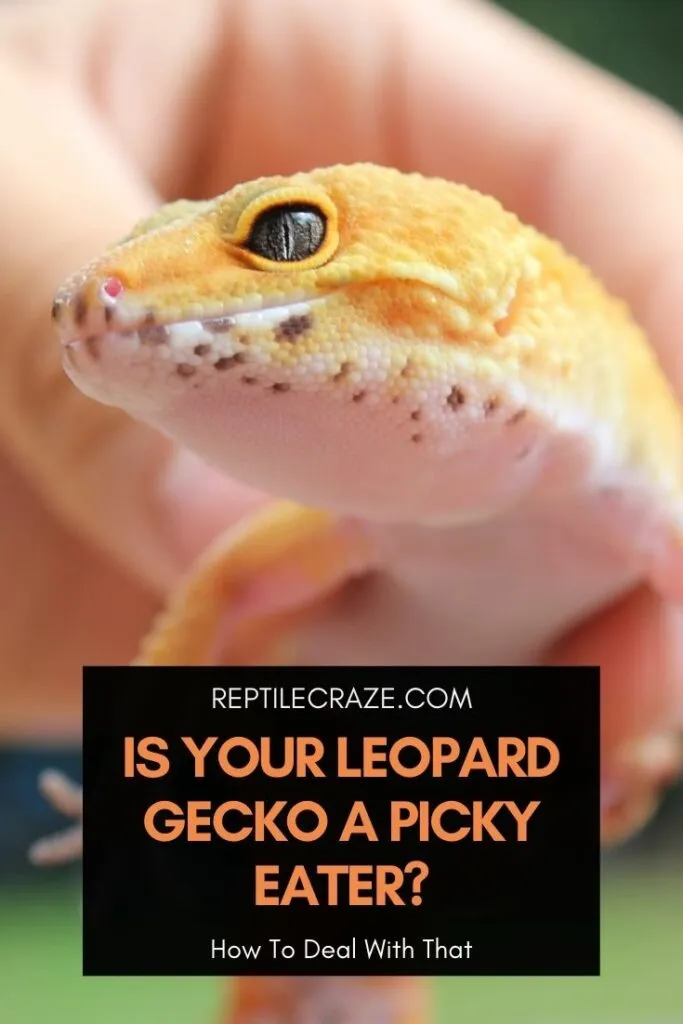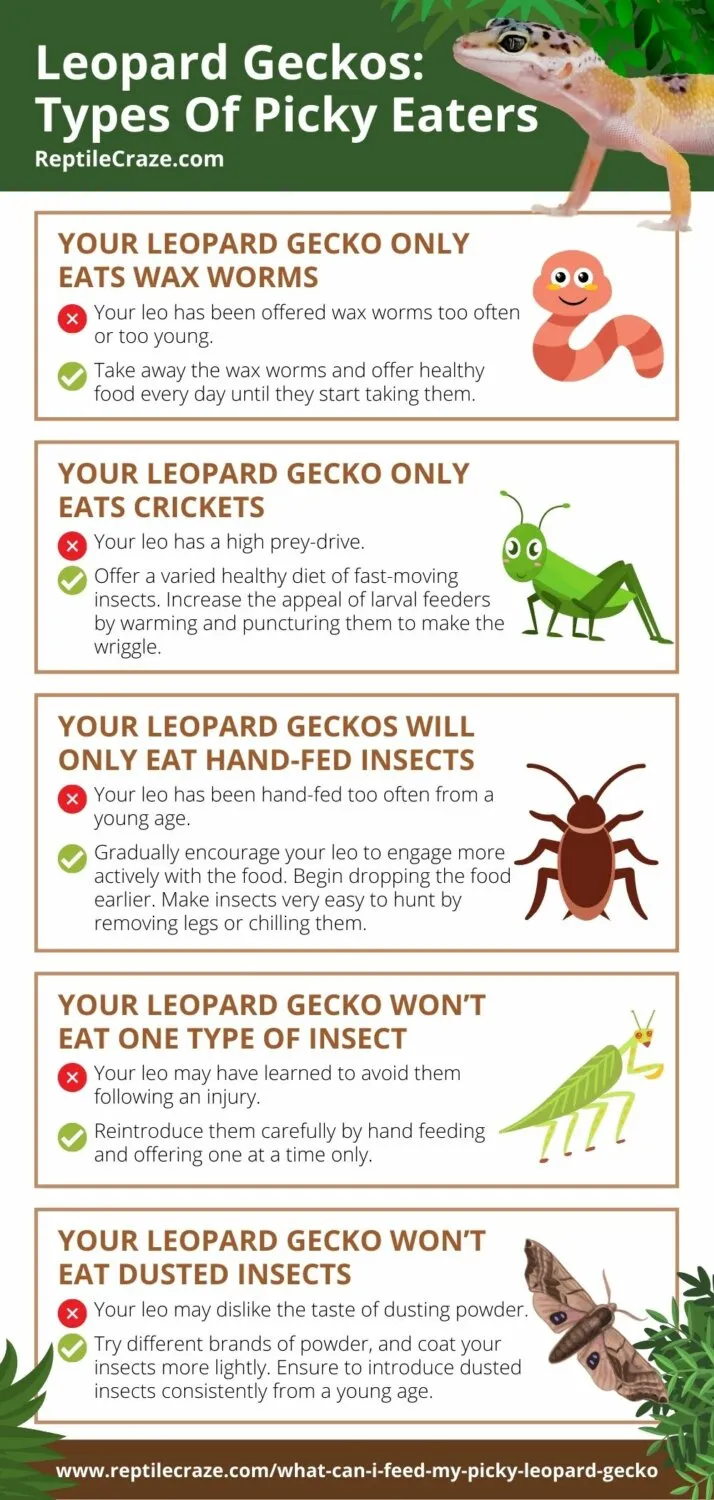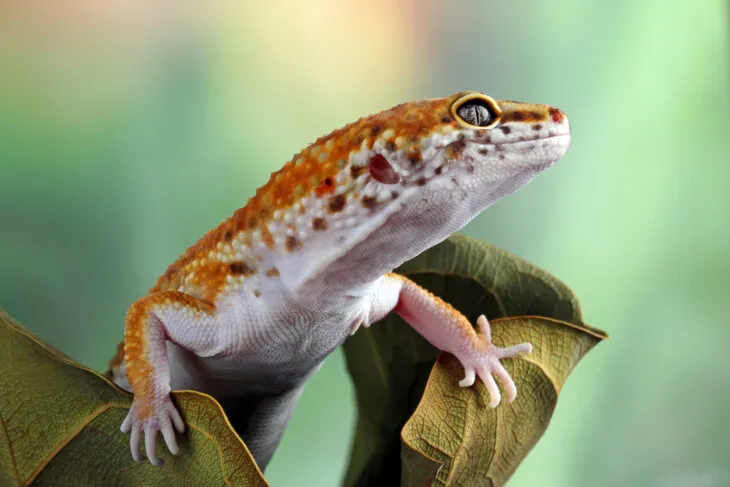
Leopard Geckos (Eublepharis macularius) can be picky eaters and sometimes start to accept only one type of insect. But how can this happen and what can you do about it? How do you feed a Leopard Gecko that is a picky eater?
If your Leopard Gecko will only eat wax worms, you should stop feeding wax worms and offer staple feeder insects daily until they take them. If your Leopard Gecko will only eat crickets, offer a varied diet of fast-moving insects, and increase the appeal of worms by warming and puncturing them.
That’s the short answer, but let’s explore what type of picky eater your Leopard Gecko is and what we can do about it. First, have a look at the infographic we created for you. After that, we’ll go into detail.

In this article, we will be focussing on picky eaters that will only accept certain foods. If your Leopard Gecko is not eating at all, click through to read our article that explains why your leopard gecko isn’t eating at all.
Table of Contents
Your Leopard Gecko Will Only Eat Fatty Larval Feeders
A common problem among Leopard Gecko owners is that their pets get addicted to fatty treats such as wax worms. Then, they won’t accept any staple feeder insects such as crickets and dubia roaches.
Because wax worms are so fatty and calorific, they taste amazing to your Leopard Gecko. Also, your Leopard Gecko will enjoy eating them because fatty foods cause dopamine to be released in the brain.
As a result, Leopard Geckos often prefer fatty foods like wax worms and can start holding out in hopes of being offered this particular
Prevent Your Leopard Gecko From Becoming Addicted To Wax Worms
The best way to avoid a picky-eating Leopard Gecko that only accepts high-fat larval feeders is prevention. High-fat foods should not be used as a staple feeder insect. Instead, wax worms should be offered as a sporadic treat only.
Also, we don’t recommend feeding high-fat treats to young Leopard Geckos. During the first months of their lives, you need to be introducing a wide range of healthy staple feeder insects.
Otherwise, they are likely to develop a reference for fatty treats that is difficult to break.
Break Your Leopard Gecko’s Wax Worm Addiction
If your Leopard Gecko is already addicted to wax worms and is a picky eater, you need to stop offering wax worms. Instead, offer staple feeder insects.
If he won’t eat, offer them again the next day. Don’t wait 2-3 days between offerings, as you usually would. Keep offering until he eats some.
You are likely to have the best luck with mealworms and black soldier fly larvae in the beginning. This is because they are also worms and are higher in fat than crickets. Later, introduce crickets and dubia roaches.
Your Leopard Gecko Will Only Eat Lively Crickets
Some Leopard Geckos are a totally different type of picky eater. These Leopard Geckos ignore worms and only eat crickets. This is because Leopard Geckos are stimulated to hunt and eat by movement.
As a result, some Leopard Geckos are uninterested in worms, and ignore them when they are offered. There are two approaches that you can use to vary the diet of this type of picky eater.
Offer A Varied Diet Of Fast-Moving Prey
There are plenty of staple feeder insects that move in fast and exciting ways. These are likely to pique the interest of your picky eating Leopard Gecko.
Try offering grasshoppers/locusts, dubia roaches, and even flying insects such as moths!
It is likely that your Leopard Gecko will take to these mobile insects. It is great that your Leopard Gecko is so stimulated to hunt and feed himself.
If you need to increase the fat in your Leopard Gecko’s diet, but he won’t take worms, try silk moths. They don’t fly but they do flap and walk around, and they contain more fat than crickets.
Make Larval Feeders More Appetizing
The other thing that you can do, is to make larval feeders such as mealworms, black soldier fly larvae, silkworms, etc, more appealing to your picky Leopard Gecko. You can do this by making them move more.
To make larval feeders move more you need to ensure they are warm enough. If you keep larval feeders in the fridge to extend their lifespan, ensure you allow them to warm up for a few hours before offering them to your Leopard Gecko.
Also, ensure that you hydrate and gut load your larval feeders in the 48 hours before offering them to your Leopard Gecko.
Not only is this very important to your Leopard Gecko’s health, but it will also give the larval feeders a bit more energy.
You can also make a little cut in the larval feeder, to allow some guts to spill out. These tasty juices will really get your Leopard Gecko going, and also may cause the worm to squirm about more.
Lastly, try using hand feeding or tong feeding to make the worm more exciting. The added movement of your hand can stimulate your Leopard Gecko to hunt the worm you are offering.

Your Leopard Gecko Will Only Accept Hand-Fed Insects
Hand-feeding your Leopard Gecko can be a great technique that helps to build trust. It can also be used to introduce new insects, or support a sick Leopard Gecko.
You can learn more about hand-feeding Leopard Geckos in our feature article.
Unfortunately, overuse of hand-feeding can lead to a dependent Leopard Gecko that won’t catch his own
Gradually Teach Your Leopard Gecko To Catch Insects
To help a picky-eating Leopard Gecko that won’t hunt, you should gradually encourage them to catch their own
Over time, you can get them pouncing toward the insect you’re holding, stalking your hand, and generally engaging with the
Then, begin to drop the
As they become more confident with “hunting”, introduce insects that are stimulating, but easy to catch. For example, you can offer very wriggly worms (see instructions above). Or, you can offer crickets with a leg missing, for example.
Encourage your Leopard Gecko to hunt more and more in small steps. You should not simply stop hand-feeding and throw crickets in the
If your Leopard Gecko doesn’t know how to hunt, it may not begin hunting as a result of being very hungry.
You Leopard Gecko Has Learned To Avoid Certain Insects
Like all animals, Leopard Geckos have the ability to learn from their experiences in order to survive. If a Leopard Gecko has been hurt by a particular insect, he may have learned to stay away from that insect.
This would most likely have been the result of crickets that were left in the
Crickets and some other feeder insects can bite and nibble on your Leopard Gecko and cause small injuries.
To get your Leopard Gecko eating these insects again will take some patience. First, select smaller insects that your Leopard Gecko can definitely manage confidently. Only ever offer one insect at a time.
Next, try hand-feeding a few of these insects to get your Leopard Gecko interested in eating them again. In order to graduate from hand feeding, you may need to remove the legs from the cricket, or otherwise make the insect very easy to catch.
Lastly, never leave your Leopard Gecko with free-ranging insects in the
Your Leopard Gecko Won’t Eat Heavily Dusted Insects
Commonly, Leopard Geckos can be picky about eating dusted insects. Preparing live feeder insects by dusting them with calcium and vitamin powder is very important for the health of your Leopard Gecko. Therefore, you can’t stop doing it.
However, dusting insects makes them less palatable. Many Leopard Geckos don’t like to eat them. There are a few ways to prevent and solve this problem.
Firstly, you can prevent the problem by dusting all insects from when your Leopard Gecko is a baby. By introducing dusting early, your Leopard Gecko will learn that the taste of dusted insects is normal.
Secondly, think about the brand of dusting powder you are using. Experiment with a few powders and see if your Leopard Gecko is more accepting of some than others.
Lastly, avoid over-dusting. Insects do not need to be heavily dusted, just lightly coated. It is better that your Leopard Gecko consistently eats lightly dusted insects than refuses to eat dusted insects at all.
- Enchi Ball Python: A Unique and Stunning Morph of Python regius - March 27, 2025
- Emerald Tree Monitor: The Enigmatic Green Guardian of the Rainforest - March 26, 2025
- The Egyptian Cobra (Naja haje): A Fascinating Serpent - March 25, 2025
